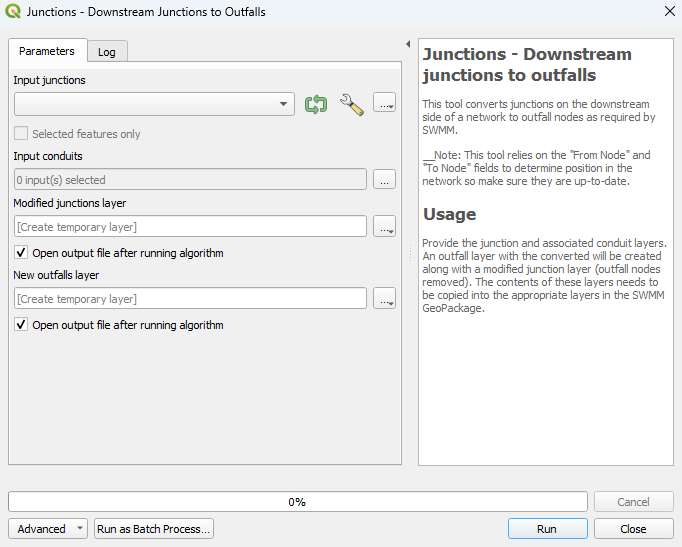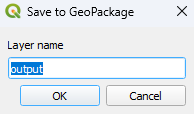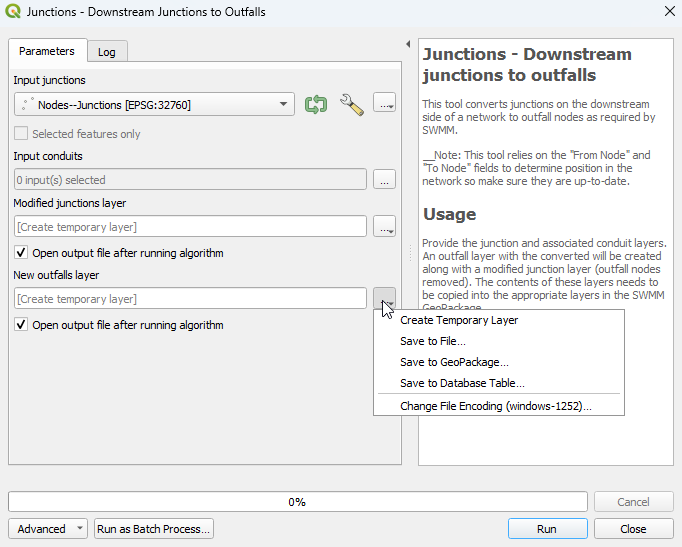QGIS SWMM Junctions Set Attributes
Introduction
This tool sets SWMM junction attributes Ysur (maximum surge depth), and Apond (area of ponding). The junction attributes are set based on generic rules and individual nodes may need to be modified.
This tool supports in-place editing if selected in the QGIS processing window.
Usage
This tool can be found in the QGIS processing toolbox panel under 'TUFLOW > SWMM'. To open the Processing Toolbox Panel, navigate to 'Processing' in the menubar and select 'Toolbox'.

Parameters
- Input junctions: Use the dropdown menu to select the existing junctions layer that will be updated.
- Input conduits: Select the ... button and tick on the conduits layer that the junctions are snapped to.
- New outfalls layer: Determines the output file. Details on the options are below.
Output Options:
For each of the following options, the tool will create a new outfalls layer and won't overwrite the existing one.
- Create Temporary Layer:
- Creates a temporary scratch layer. This layer will open into the QGIS workspace but it will not be saved anywhere.
- Save to File...:
- The user can navigate to a folder and save the updated outfalls layer to a new GeoPackage Database.
- Save to GeoPackage...:
- Save to Database Table...:
- ???
- Append to Layer...:
- ???
The recommended settings for junctions within the 2D domain depends on whether the node receives flow from a subcatchment and whether and how the node is connected to the 2D domain. The recommended attribute settings for junction nodes are:
Junction nodes receiving subcatchment flows
Nodes receiving flows from subcatchments use the recommended settings to allow any discharges unable to be conveyed through the node to immediately enter the 2D domain. These discharges are reported as "flooding" by SWMM.
Ysur = 0.0 (forced)
Apond = 0.0 (forced)
Junction nodes not receiving subcatchment flows connected to a 2D Domain
When nodes do not receive flows from subcatchments, it is recommended to allow ponding (set Apond >0). This will allow the head in the node (including pressure head) as a water level. If the water level in the node exceeds the water level in the 2D domain, there will be a flow from the 1D domain to 2D domain.
Junction nodes connected with an inlet
When nodes are connected through an inlet, either Ysur (surcharge dpeth) or Apond (area of ponding) can be used to allow the pressure head to exceed Ymax (by default highest adjacent conduit soffit). Using a positive area of ponding may enhance stability. When used, Apond should represent the manhole shaft or a small area. A larger area may enhance model stability but may artificially attenuate discharges. If Apond is non-zero, Ysur is ignored.
Ysur = 0.0 if ponding otherwise higher than expected depths to prevent flooding
Apond = Manhole area
Junction nodes connected with a HX boundary (no inlet)
When nodes are connected through an HX boundary such as culverts through an embankment, it is recommended to set apond (area of ponding) to the approximate area of connected cells. A larger area of ponding may improve stability but may artificially attenuate discharges. This will depend on the model cell size. Generally, a typical value is chosen that is reasonable for most of the connections and any signficantly larger or smaller structures can be modified on an individual basis.
Ysur = 0.0
Apond = Typical area of connected 2D cells (higher values may aid stability).
Junctions not connected to 2D domains
Flood losses would be lost from the model resulting in mass losses and inaccurate results. Prevent by allowing ponding or making surge elevation high.
Option #1
Ysur = higher than expected node depths
Apond = 0.0
or Option #2
Ysur = 0.0 (ignored)
Apond = (positive number)
Note: It is recommended that Ymax be set to 0.0 for all junctions. SWMM will set Ymax to higest soffit of connected conduits.
Example
| Up |
|---|


